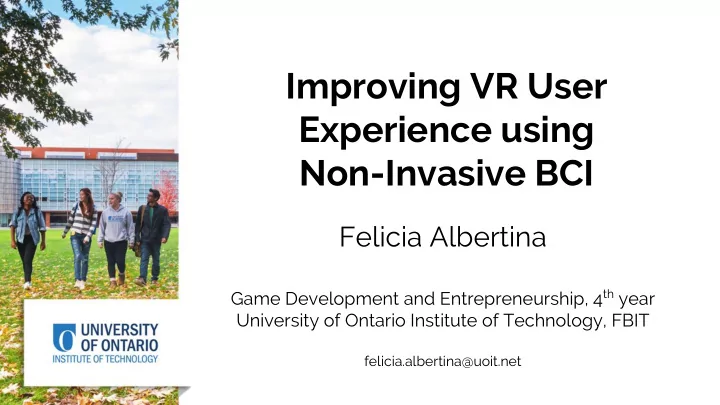

Improving VR User Experience using Non-Invasive BCI Felicia Albertina Game Development and Entrepreneurship, 4 th year University of Ontario Institute of Technology, FBIT felicia.albertina@uoit.net
Introduction The demand for Virtual Reality (VR) has been growing for the last five years. The market demand for the VR system has grown steadily, with a lot of research and development process being done not only in video games, but also in other areas such as news, film industries, medical simulations, healthcare and clinical therapy. With the growing interest directed towards the virtual reality technology, it is crucial to keep on improving the current system that already exist and improve the interactivity and the immersion of the virtual space.
Starting at 2016, VR technology has been widely commercialized and has seen significant growth and it is predicted to be continuously growing https://techcrunch.com/2017/01/11/the-reality-of-vrar-growth/
− Japan is pioneering the VR technology and companies invested million dollars for VR research New VR center in Tokyo − Dedicated VR theme park − IMAX VR Center in Tokyo − Japan Universal Studios Final Fantasy VR − http://www.usj.co.jp/universal-cool-japan2018/ff/ https://www.engadget.com/2017/07/18/vr-zone-shinjuku-project-i-can-tour/
Background - Users do not feel comfortable with the device - Developers are still trying to figure out the issues during development process. - During user testing process, participants missed a lot of important points - During VR interactions there are a lot of Quantitative and Qualitative data - Surveys which measures user perceptions - Other physiological movements - Source: - Tussyadiah I., Wang D., Jia C. - Negishi Y., Mitsukura Y., Fukai H, Tomita H.
Justification - VR technology has great potential Requires more research - Understand the user needs - http://www.pjamal.com/2016/10/vr-in-classroom-future-of-experiential.html http://www.technologiesblog.eu/the-unbelievable-potential-of-vr-isnt-video-games-or-pictures-its-medication/
Goal − Using EEG sensors to obtain user’s brain signal activity and use the data to improve VR simulations
http://blog.wupingxin.net/2014/10/11/brain-wave-controlled-traffic-simulation-control-a-vissim-simulated-car-in-your-mind-1/
http://neurosky.com/ http://www.dglab.com/
Case Study - Several case studies was conducted to learn human’s psychological condition, i.e. emotions, interest, and comfortability using EEG sensors - A study to learn neural pattern recognition and create a system capable of identifying complex emotions using EEG. (Kanoga S., Mitsukura Y.) The experiment has successfully achieved the goal of classifying the - participants’ complex emotions and multiple emotional states
Case Study – cont. - A study was conducted to find an association between comfortability and visual information when looking at streetscapes using EEG sensors and Questionnaires. (Yamaguchi S., Mitsukura Y.) - Some comfortabilities were detected only by using EEG
Challenges Non-invasive BCI is susceptible to noise − − Ethical issues – privacy − Device can be overwhelming − Cost issues − Better integration with VR
Conclusion - Certain relevant informations and datas are not obtainable through performing surveys and questionnaires alone - With the growth of VR technology and the availability of consumer-level BCI devices it is advantageous to use the two technologies together
https://www.youtube.com/watch?v=47WHqDNckI8
Reference ● [1] S. Wang, I. Ken, T. Hiromi, T. Akihiro, and T. Satoshi. “Photorealistic VR Space Reproductions of Historical Kyoto Sites based on a Next-Generation 3D Game Engine” in Journal of Advanced Simulations in Science and Engineering Vol. 1, No. 1, pg 188-204, 2015 [Accessed February 4, 2018] [2] T. Iis, W. Dan, and J. Helen. “Exploring the Persuasive Power of Virtual Reality for Destination Marketing” in Tourism Travel and Research Association: ● Advancing Tourism Research Globally, 2016 . [Online] Available: http://scholarworks.umass.edu/ttra/2016/Academic_Papers_Oral/25 [Accessed February 4, 2018] ● [3] K. Suguru, and M. Yasue. “A Study of Pattern Recognition in Children using Single-Channel Electroencephalogram for Specialized Electroencephalographic Devices” in Electronics and Communications in Japan, Vol. 100, No. 11, 2017. [Accessed February 4, 2018] ● [4] Y. Sunao, and M. Yasue “Construction of Comfort Evaluation System for Streetscape Improvement Using Electroencephalogram” in 8th International Conference on Information Technology and Electrical Engineering (ICITEE), 2016. [Accessed February 4, 2018] ● [5] Cnn.com. (2018). [online] Available at: http://www.cnn.com/travel/article/vr-parks-on-japan/index.html [Accessed 7 Feb. 2018]. [6]Dglab.com. (2018). DG Lab | BRAIN WAVE VR – Connecting Brain Waves Into New Virtual Realities . [online] Available at: ● https://www.dglab.com/en/brain-wave-vr-en/ [Accessed 7 Feb. 2018]. ● S. Vaid, P. Singh and C. Kaur, "EEG Signal Analysis for BCI Interface: A Review," 2015 Fifth International Conference on Advanced Computing & Communication Technologies , Haryana, 2015, pp. 143-147.
Recommend
More recommend